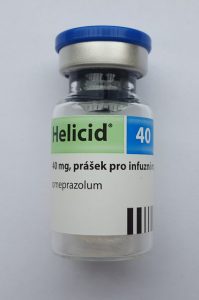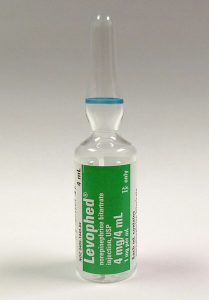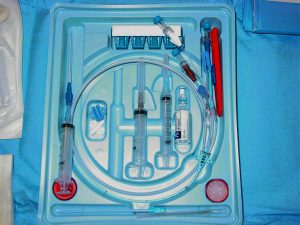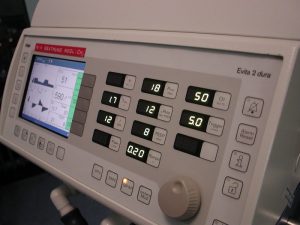
“Effect of Intravenous Omeprazole on Recurrent Bleeding After Endoscopic Treatment of Bleeding Peptic Ulcers”
N Engl J Med. 2000 Aug 3;343(5):310-6. [free full text]
—
Intravenous proton-pump inhibitor (PPI) therapy is a cornerstone of modern therapy for bleeding peptic ulcers. However, prior to this 2000 study by Lau et al., the role of PPIs in the prevention of recurrent bleeding after endoscopic treatment was unclear. At the time, re-bleeding rates after endoscopic treatment were noted to be approximately 15-20%. Although other studies had approached this question, no high-quality, large, blinded RCT had examined adjuvant PPI use immediately following endoscopic treatment.
The study enrolled patients who had a bleeding gastroduodenal ulcer visualized on endoscopy and in whom hemostasis was achieved following epinephrine injection and thermocoagulation. Enrollees were randomized to treatment with either omeprazole 80mg IV bolus followed by 8mg/hr infusion x72 hours then followed by omeprazole 20mg PO x8 weeks or to placebo bolus + drip x72 hours followed by omeprazole 20mg PO x8 weeks. The primary outcome was recurrent bleeding within 30 days. Secondary outcomes included recurrent bleeding within 72 hours, amount of blood transfused by day 30, hospitalization duration, and all-cause 30-day mortality.
120 patients were randomized to each arm. The trial was terminated early due to the finding on interim analysis of a significantly lower recurrent bleeding rate in the omeprazole arm. Bleeding re-occurred within 30 days in 8 (6.7%) omeprazole patients versus 27 (22.5%) placebo patients (HR 3.9, 95% CI 1.7-9.0; NNT 6.3). A Cox proportional-hazards model, when adjusted for size and location of ulcers, presence/absence of coexisting illness, and history of ulcer disease, revealed a similar hazard ratio (HR 3.9, 95% CI 1.7-9.1). Recurrent bleeding was most common during the first 72 hrs (4.2% of the omeprazole group versus 20% of the placebo group, RR 4.80, 95% CI 1.89-12.2, p<0.001). For a nice visualization of the early separation of re-bleeding rates, see the Kaplan-Meier curve in Figure 1. The mean number of units of blood transfused within 30 days was 2.7 ± 2.5 in the omeprazole group versus 3.5 ± 3.8 in the placebo group (p = 0.04). Regarding duration of hospitalization, 46.7% of omeprazole patients were admitted for < 5 days versus 31.7% of placebo patients (p = 0.02). Median stay was 4 days in the omeprazole group versus 5 days in the placebo group (p = 0.006). 4.2% of the omeprazole patients died within 30 days, whereas 10% of the placebo patients died (p = 0.13).
Treatment with intravenous omeprazole immediately following endoscopic intervention for bleeding peptic ulcer significantly reduced the rate of recurrent bleeding. This effect was most prominent within the first 3 days of therapy. This intervention also reduced blood transfusion requirements and shortened hospital stays. The presumed mechanism of action is increased gastric pH facilitating platelet aggregation. In 2018, the benefit of this intervention seems so obvious based on its description alone that one would not imagine that such a trial would be funded or published in such a high-profile journal. However, the annals of medicine are littered with now-discarded interventions that made sense from a theoretical or mechanistic perspective but were demonstrated to be ineffective or even harmful (e.g. pharmacologic suppression of ventricular arrhythmias post-MI or renal denervation for refractory HTN).
Today, bleeding peptic ulcers are treated with an IV PPI twice daily. Per UpToDate, meta-analyses have not shown a benefit of continuous PPI infusion over this IV BID dosing. However, per 2012 guidelines in the American Journal of Gastroenterology, patients with active bleeding or non-bleeding visible vessels should receive both endoscopic intervention and IV PPI bolus followed by infusion.
Further Reading/References:
1. Wiki Journal Club
2. 2 Minute Medicine
3. UpToDate, “Overview of the Treatment of Bleeding Peptic Ulcers”
4. Laine L, Jensen DM. “Management of patients with ulcer bleeding.” Am J Gastroenterol. 2012
Summary by Duncan F. Moore, MD
Image credit: Wesalius, CC BY 4.0, via Wikimedia Commons




